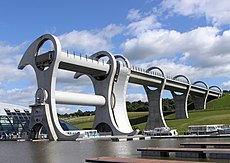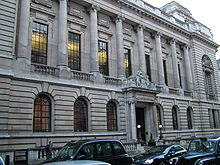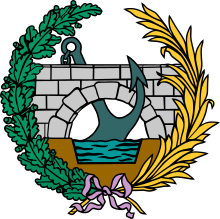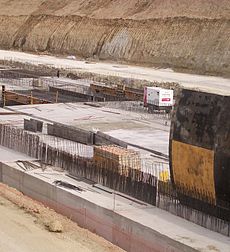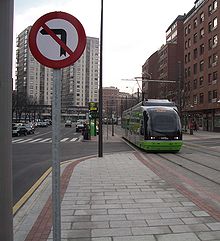Civil Engineering
Civil engineering is the discipline of engineering that uses knowledge of calculation, mechanics, hydraulics, and physics to take charge of the design, construction, and maintenance of the infrastructures located in the environment, including roads, railways,, bridges, canals, dams, ports, airports, dikes and other related constructions. Civil engineering is the oldest after military engineering, hence its name to distinguish civil activities with military ones. Traditionally it has been divided into various sub-disciplines including environmental engineering, sanitary engineering, geotechnical engineering, geophysics, geodesy, structural engineering, transportation engineering, earth sciences, urban planning, land use planning, hydraulic engineering, ecology, biology and microbiology, materials science, coastal management, construction engineering and building engineering. The civil engineer holds internship positions mind all levels: in the public sector from the municipal to the governmental level and in the private sphere from small freelance consultants who work at home to those hired in large international companies.
History of civil engineering
Engineering has been an aspect of life since the beginning of human existence. The earliest practices of civil engineering could have started between 4000 and 2000 BCE. C. in Ancient Egypt and Mesopotamia when humans began to abandon their nomadic existence, creating a need for shelter. During this time, transportation began to increase in importance, which led to the development of the wheel and navigation.
Until the Contemporary Age there is no clear distinction between civil engineering and architecture, and the terms engineer and architect suffered variations referring to the same person, even being interchanged. The construction of the Egyptian Pyramids between 2700 and 2500 BC. C. could be considered the first manifestations of constructions of great size and importance. Other historical constructions include the Qanat water management system, the Parthenon by Ictinus in Ancient Greece (447-438 BC), the waterway Apia by Roman engineers or the Great Wall of China in 220 B.C. C., or the irrigation works in Anuradhapura. Of all the ancient civilizations, perhaps the most developed in civil engineering were the Romans who were pioneers in the construction of a network of roads, aqueducts, ports, bridges, dams and sewers.
In the 18th century the term civil engineering was coined to incorporate all engineering for civil uses as opposed to military engineering (artillery, ballistics, construction of defenses...). In 1747 the oldest civil engineering school in the world was created, the École nationale des ponts et chaussées in Paris, which is still in force today. The first self-proclaimed civil engineer was John Smeaton who built the Eddystone Lighthouse. In 1771 Smeaton and some colleagues formed the Smeatonian Society of Civil Engineers, a group of professionals who met daily to discuss their profession. Through these meetings the professional societies we know today were formed.
In Spain, the need to create a specific engineering corps to be in charge of public works was considered, for this reason the Official School of the Civil Engineering Corps directed by Agustín de Betancourt was founded in 1802. At that time, Mexico was already it had established the first research institute specialized in civil engineering and in 1857 the teaching of civil engineering was instituted at the Academy of San Carlos based on the European curricula.
Academic training
Civil engineers have an academic degree in civil engineering. The study time is between four and five years for the graduate degree in engineering (bachelor of engineering in Anglo-Saxon countries), which is necessary to be able to subsequently study the Postgraduate studies (Master of Engineering and Doctor of Engineering degrees).
In most countries, the university degree represents the first step to professional certification, and the degree program itself is certified by a professional body. After completing a certified degree program, an engineer must satisfy a series of requirements (including work experience and an exam) before being certified. Once certified, the engineer is designated with the title of professional engineer (in the United States, Canada, and South Africa), or chartered engineer (in most Commonwealth countries), chartered professional engineer (in Australia and New Zealand), or European engineer (for some countries of the European Union). There are international agreements between engineering colleges that allow engineers from other countries to practice outside their borders. In Spain, anyone who completes a degree can practice and become a member of the association, without any additional requirements such as experience or exam.
The benefits of certification vary from site to site. For example, in the United States and Canada "only a licensed professional engineer may prepare, sign and seal, and deliver an engineering project to a public authority for approval, or seal for public or private clients." In the state of Quebec, in Canada, this is so. In the United Kingdom there is no such restrictive legislation or in Spain, although there are associations that can expel their members for malpractice and thus not be able to practice. All engineers are supposed to abide by a code of ethics and if they don't follow it they can be blamed for negligence.
Spain
In Spain there is currently a degree in Civil Engineering, Public Works or Civil and Territorial (among other names depending on the university that grants it). granted) of 4 years and 240 ECTS), as well as the master's degree in Caminos, Canals and Ports Engineering of between 1 and 2 more years and 66 to 120 ECTS). Previously, there were the official qualifications of Public Works Technical Engineer and Caminos, Canals and Ports Engineer, which correspond to the current regulated professions of the same name. Such degrees generally include units covering physics, mathematics, project management, construction, design, and specific civil engineering topics. Normally at the beginning of the degree the subjects cover most, if not all, of the sub-disciplines of civil engineering. Students then choose to specialize in the final part of the degree in one or more subdisciplines with a view to completing their degrees. In addition to the Master's Degree in Road, Canal and Port Engineering, which attributes specific competencies In addition to this regulated profession, universities generally also offer specialized master's degrees to improve the civil engineer's knowledge in an area of particular interest within civil engineering.
Latin America
Currently, 5 or 6 years are studied for the "Degree in Civil Engineering", which is necessary to pursue postgraduate studies, such as "master or Master in engineering sciences", then the "doctorate". The subjects necessary to obtain the Civil Engineer Degree must be taken in subjects such as Basic Sciences, Engineering Sciences, Advanced Mathematics, Applied Engineering, Economic and Administrative Sciences[required appointment].
Fields of application
Its field of application is very wide. For example, there would be transport infrastructures:
- Airports
- Motorways
- Roads
- Railway routes
- Ports
- Bridges
- Urban transport networks
Hydraulic works:
- Sewerage
- Channels for the transport of drinking water or irrigation
- Navigation channels
- Drinking water pipelines
- Hydroelectric power stations
- Debuggers
- Dikes
- Locks
- Piers
- Prisoners
- Driving pressure
Intervention on ground stability problems.
The structures that make up the previous works:
- Terraplens
- Dismounts
- Ground containment works
- Tunnels
- Zapatas
- Pillars
- Vigas
- Strings of bridges
In general, civil engineering works involve the work of a large number of people (sometimes hundreds and even thousands) over periods ranging from a few weeks or months to several years.
Due to the high cost of the works that are undertaken (think of the cost of a highway or a railway line) a good part of the works that are carried out are for the State, or for large companies that intend to exploit of a long-term infrastructure (highways and toll tunnels, railway companies, etc.). However, his techniques are also applied to works similar to the previous ones but on a smaller scale, such as:
- The containment of a difficult terrain in excavation for the foundation of a building.
- The execution of the structure of a building.
- The design and implementation of the drinking water and sewage distribution systems of a small population (including drinking water treatment stations (ETAP), pumping equipment, waste water purification stations (EDAR), etc.
- The design and urbanization of the streets of a small population
In addition, they are also the responsibility of a civil engineer:
- Planning, design and control of urban transport systems, including the design of exchangers and the creation of new lines or modification of existing ones.
- Adoption of new transport systems that do not exist at that time, such as subway lines or light meter (more commonly known as tram).
- The development of studies and work related to transport and logistics.
- The development of land and environmental studies, plans and projects.
- Planning, execution and management of waste and landfill treatment plants.
- Engineering auxiliary work (quality control, laboratory tests, supervision of safety and health issues).
- Maintenance of all previous
In this way, a civil engineer is not limited to large infrastructure works, very rare due to their high cost.
Subdisciplines
There are a number of subdisciplines within the broad field of civil engineering. General civil engineers work closely with surveyors and specialized civil engineers to design grading, drainage, paving, water supply, sewerage, dams, electrical supply, and communications. General civil engineering is also known as site engineering, a branch of civil engineering that primarily focuses on converting a tract of land from one use to another. Site engineers spend time visiting project sites, meeting with interested parties, and preparing construction plans. Civil engineers apply the principles of geotechnical engineering, structural engineering, environmental engineering, transportation engineering, and construction engineering to residential, commercial, industrial, and public works projects of all sizes and levels of construction.
Civil engineering work
The work of a civil engineer begins when a certain need arises (a new dock in a port, the expansion or construction of a highway, a dam that gives continuity and stability to the flow of a river...). In this planning stage, civil engineers work in an integrated manner with other professionals and national or local authorities with decision-making power.
Then comes the work of compiling the necessary data for the design of a solution to said need, data that can be topographic (measurement of the real surface of the land), hydrological (rainfall of a basin, flow of a river, etc.), statistics (capacity of existing roads or streets, population densities), etc.
For this purpose, the designs of the most complex works and systems are made in several stages. The first stage called pre-feasibility, is responsible for analyzing the largest number of possible solutions. It is at this stage in which the competent bodies will decide, for example: the location of a port, the general layout of a highway or they will make the decision regarding whether to build a railway for the transport of minerals or a mineral pipeline. For decision-making, the following points of view are considered, among others: difficulty of the work; cost of the work; environmental impact produced by the work. The pre-feasibility study involves a multidisciplinary team of technicians, where, in addition to civil engineers, electrical and mechanical engineers, geologists, economists, sociologists, and ecologists participate. As a result of this phase, 2 or 3 solutions are chosen to detail them in the next stage.
In the next stage, called technical-economic feasibility, much progress has already been made in the construction details, in the determination of costs, in the construction schedule and in the cash flow necessary for the execution of the work. At this stage, field investigations are very important to detect specific difficulties related to the geology of the areas in which intervention will take place, and the environmental impacts will be detailed, including both the physical, abiotic and social aspects. In general, it is in this phase that the definitive solution is chosen, which will be detailed in the final design or executive project stage.
Then comes the real work on the ground: conditioning it so that it is capable of supporting the structures that are going to be built on it (sometimes going so far as to replace the ground with another with a greater bearing capacity if the existing one does not meet the conditions necessary), earthworks (clearings and embankments), construction of structures (piles, footings, pillars, abutments, beams, retaining walls).
However, all of these steps are rarely performed seamlessly, let alone by the same engineering team. Thus, it is often the corresponding Administration engineers who detect the need to be solved, while on other occasions the work is included in a political action plan (not always with a clear technical justification).
If the work to be undertaken is large-scale, the Administration does not execute it, but rather its engineers prepare a preliminary project that is put up for public auction. Then it is the engineers of the different construction companies who, based on the technical prescriptions of the draft, elaborate different alternatives. The alternatives offered by the construction companies can be very different from the draft and from each other, since each company makes use of the machinery and procedures that are best known to it, and the Administration will choose the cheapest option that meets the requirements.
The engineers who carry out the work do not have to be (and generally are not) the ones who designed it. The construction company may also decide to subcontract different jobs to other companies, so there may be different companies for the same project (one carries out the earthworks, another the concrete structures...) each with its corresponding engineering department. and its corresponding team of engineers on site.
Very often, due to the unpredictability of the terrain, problems occur on site that force modifications to the project; On other occasions, the Administration may decide to vary some conditions or requirements as the work develops and problems or possibilities are observed that had not been studied or that were not considered important at the time the draft was prepared. It may happen that a new infrastructure requires modifications or the possibility arises that two different works, built by different companies (of course with different teams of engineers) are executed together.
All of this can give you an idea of the large number of variables that affect civil engineering work. Large-scale works are rare, and more frequently the civil engineer is limited to supervising the work and making specific decisions on specific problems that do not affect the development or general budget of the work. Thus, works such as the containment of a terrain with usual characteristics, the placement of a prestressed beam or the execution of a pavement, are routine works that do not imply significant changes in the project.
Contenido relacionado
High performance cluster
MediaWiki
Cybernetics
